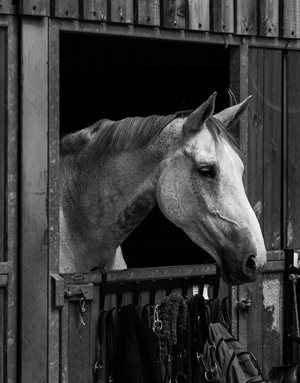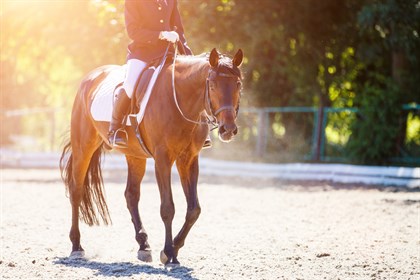
This article has appeared previously with Equestrian Life. To see what is in our latest digital issue, please click here.
Generally a schoolmaster is a mature horse that is very receptive to a range of riding challenges.
DR WARWICK VALE BSC BVMS(HONSII) has been an FEI Veterinary Delegate for over 10 years and specialises in FEI Veterinary issues. Warwick has completed two FEI Veterinary Accreditation and Training courses, officiated at over 25 FEI events, in CSI, CDI and CIC events and officiated at over 30 other EFA/Endurance events nationally. At the Sydney 2000 Olympic Games he was the FEI Medication Control Program Supervisor and a Senior Technical Official.
By Warwick Vale
A schoolmaster horse can be described as a horse that has a rich and sophisticated vocabulary or understanding of aid pressures. Generally a schoolmaster is a mature horse that is very receptive to a range of riding challenges. They have a depth of understanding of the finer nuances of aid pressures that can help a less sophisticated rider develop better feel and timing.
The role a schoolmaster often undertakes is a teaching one; where the rider can learn and develop more advanced riding skills from the horse, i.e. the horse ‘trains’ the rider rather than the other way around. For many riders, schoolmaster horses are often ‘downgraded’ in their competition status/qualifications so that the rider may compete at a lower level than the horse’s grading.
For obvious reasons schoolmaster horses are highly sought after by younger riders (and their parents) looking to progress their riding and competition skills. Most successful elite riders will have owned or ridden a schoolmaster horse/pony at one stage in their formative riding years.
Generally it takes a lot of effort over many years for a horse to become a schoolmaster. This often entails years of training, equitation and competing. Often after such a hard working lifestyle like this a schoolmaster horse can present with a range of serious health problems that can limit or terminate its useful riding career and reduce its sale value. Many of these problems are detected during a pre-purchase examination or an annual soundness examination.
The primary and common health issue of concern is athletic unsoundness or lameness. Lameness in a horse means pain, and this pain can come from a myriad of conditions and from a number of anatomical locations/structures.
One of the most common causes of lameness in mature schoolmaster is degenerative joint disease (arthritis) in their lower limb joints. In the horse the arthritic process develops slowly with age and is exacerbated by competitive riding and training. The more a horse is ridden and competed, then the more the arthritis can develop. Simply put: degenerative arthritis is ‘arthritis of wear and tear’.
The progression or pathogenesis of degenerative arthritis in the horse is a complicated process that results clinically in localised joint swelling, pain, heat, and reduced flexibility. Flexion testing (a common veterinary diagnostic test) of affected joints often produces a worsening of the severity of the lameness and can often be resented by the horse. Other veterinary findings can include abnormal x-rays (with joint spurs, chips and arthritic change), blood tinged and inflamed joint fluid, and the thinning and ulceration of the joint cartilage surfaces within the joint that are seen on arthroscopy (camera in the joint).
With performance horses the common sites of arthritis are the pastern and fetlock joints, the coffins joints inside the hoof, and the knee and hock joints. Although arthritis can occur in any joint, it is rare to very rare in the spine, hip, stifle, elbow and shoulder of the horse. It is very important to manage any arthritis that a schoolmaster may have, and equally important to try and minimise the progression of the disease and try to prevent any other arthritis from developing. This will ensure that you optimise the riding career of your schoolmaster. A successful management plan for your schoolmaster horse would include;
1. Annual or biannual health and soundness assessment by your veterinarian, with preference being given to seeking out a veterinarian with experience in horse orthopaedics and lameness. This check should include a full soundness assessment (like a prepurchase examination) that has the horse evaluated moving at all gaits on the lunge, plus ridden by the rider and trotted in hand. An assessment of galloping and jumping may also be warranted. The aim is to get an appreciation of the overall soundness of the horse and detect any early or potentially serious lameness problems before they affect the rideability and welfare of the horse. X-rays may be required.
2. A training regime that doesn’t stress or strain the limits of the soundness of the horse. Usually, schoolmaster horses don’t need as much training as other horses and as such they shouldn’t be ridden ‘into the ground’ or over trained. It is not a good idea to put a heap of extra ‘miles’ on the legs of these horses just for the sake of training. Don’t confuse training with fitness. A schoolmaster that is competing still needs to be fit, strong and supple, but they often don’t need to be trained that much. Leave it to competition time for the horse to have its maximum effort and stress. Regular work in smaller amounts is better for arthritic horses. Once a horse is fit maintaining the level of fitness is easier than the attainment phase.
3. Consider getting a medical management plan (in consultation with your vet) for any arthritis or unsoundness your horse may have or be developing. Today there are an exhaustive number of preparations that are available for the treatment, management and prevention of arthritis in horses. In addition to the widely used anti-inflammatory products (bute, cortisone etc) there are the ‘joint protecting’ or ‘joint healing’ medicines that can be used. These come in a variety of formulations ranging from oral tablets, herbs, powders and other supplements, plus lotions, bandages and injections. Many of the oral supplements have yet to be proven to be efficacious for arthritis, and often do not live up to expectations despite widespread use. Most of the supportive veterinary research and literature on the treatment of arthritis in horses has been attached to the use of injectable products and in this area the use of medicines like Pentosan, Cartrophen, Hyonate and Enhance is widespread. These medicines belong to the family of anti-arthritic compounds called glycosaminoglycans. These are proven scientifically to be effective medicines for the treatment of degenerative joint disease in horses.
These medicines can be expensive, but when used strategically in a tailored arthritis management plan they can be extremely valuable and effective. Most schoolmasters are worth the extra expense. Talk to your vet – they are the experts in this area. The use of anti-inflammatories medicines for the management of arthritis in schoolmasters can be contentious. They are often very effective at reducing pain and returning soundness to the horse but many argue that their use should be limited because the overall welfare of the unsound horse may be better served by retirement rather than regular anti-inflammatory treatments. Unlike the glycosaminoglycans they are prohibited medications for use during competition and they can have side effects. It is best to discuss the use of inflammatory medicines with your veterinarian, he or she will know you, your horse and its problems – and can be best placed to give you advice on all the options for the appropriate care of your horse. Don’t get overly concerned about the use of inflammatory medicines, as most horses only require strategic application of these drugs and overall the improvement in the welfare and soundness of the horse is a positive one.
4. Keep your horse in good general health and condition. Feed properly – not too fat and not too thin is the goal. Add electrolytes, minerals and vitamins when needed – consider getting expert advice on the nutrition of your horse. Older schoolmasters often have trouble keeping condition so it may be better to explore the specialised foods for older horses that are in work. This will make it easier for you to keep your horse in good weight. Vaccinate for strangles and tetanus. Worm regularly. Protect your valuable schoolmaster from the elements and take care to risk situations where he could get injured or damaged.
5. Protect your horse during riding from potential injury – use the appropriate supportive boots and bandages when working or competing the horse.
6. Maintain excellent hoof care and farrier attention. Remember ‘no foot – no horse’. Hoof lameness accounts for the bulk of forelimb lameness and most hoof lameness is preventable.
Love your schoolmaster, look after and treasure him or her well. Plan to have someone else get the value out of your horse long after you have moved on to your next one. True schoolmaster horses are invaluable and it is no wonder that they get handed down from rider to rider within families without ever getting sold. Most change hands without any advertising and go on to provide training and experience to many more riders. If only they could go on forever – it’s worth looking after their soundness and health – prevention is better than cure.
READ THE LATEST NEWS ARTICLES HERE
https://www.equestrianlife.com.au/articles/Managing-Your-Schoolmaster


